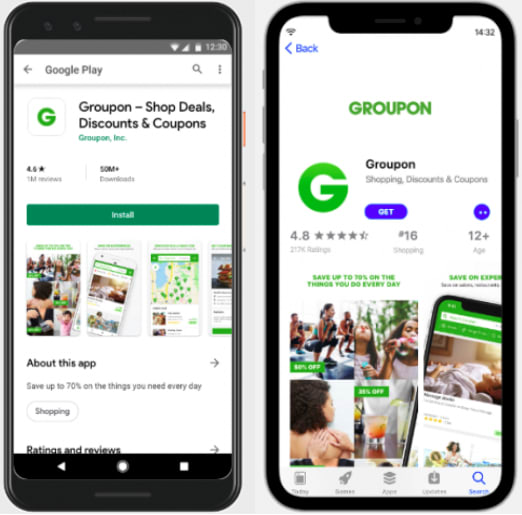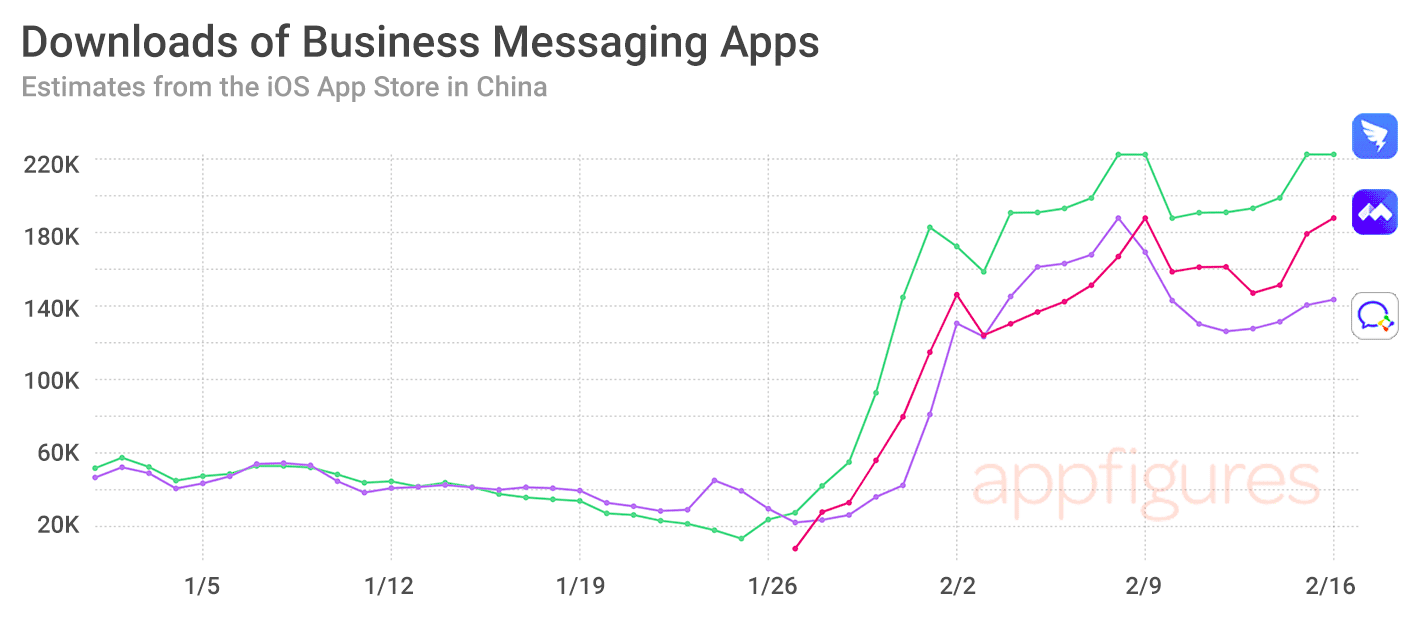As a big fan of the not-leaving-the-couch philosophy, if a rampant viral outbreak helps plead my remote-work case to the boss then I’m not going to be the one to complain.
Not all bandaids fit all wounds
Apparently, some people still think that there’s not much difference between iPhone users and those of the Android variety. And that there’s not much difference between the platforms themselves. Those ‘some people’ would be wrong.
Whilst they might look the same, all preppy-haired and glasses-wearing, if you look below the lenses you’ll see that’s pretty much it. One is a classical Jones’ neighbor and the other is the quiet guy in the corner of the party. And what works for A won’t work for B. And that’s the point. Smartphone marketers target different personas and we should be following their lead. Those personas are the same ones frequenting the app store that comes built into that phone.
What’s the cost of treating everyone the same? About a 20-30% decrease in conversion rates.
Apple users are generally more homogenous. They’re mostly found in tier-one ponds, spending more per app and engaging more with what’s in their app store environment.
Android users, still the vast majority (~71% vs ~29% for iOS according to NetMarketShare, although iOS still leads in the U.S.), are not.
Besides for the Marketing 101 lesson we learned back at school, the stores themselves are different. What appears in one, won’t appear in the other. Whether a video autoplays or not, affects what you should focus on. The poster frame that sits as a static image until the video play button is pushed? Or the video content itself?
Apple does autoplay but it limits video content to actual game features. Google doesn’t autoplay (yet, more on that below) but it does grant you unlimited creativity for what to put in your video itself. Embrace that change, embrace that difference.

| One more thing to really drive the “don’t cut and paste from one to the other” point home, is that the different layouts have different visual hierarchies. Apple tends to have much larger screenshots so a portrait orientation can be highly visible and effective and suit the layout of a phone. But Google’s smaller screenshot means the exact same image is a microscopic version of the other. That text will need a much longer arm to read (especially amongst the over 50s who left their reading glasses at home). But you can often see more than 1.3 screenshots in the first impression. Think beyond the drudgery of having to come up with two separate designs and think more of the positive effects on your conversion rates and the big boastful bonus that is certainly in your future if you do it right. |
The end of the world is nigh
And by the world, I mean user-level mobile marketing attribution because that’s obviously an all-encompassing synonym for our modern world today. Post-apocalyptic prophecies are rampant and spurred on by a few key indicators of the pretty much inevitable deprecation of IDFA ― a dark cloud hanging over the heads of all mobile marketers. Privacy (and the demand for it) seem to be taking center stage in retaliation to the overgrown and uncontrolled desired for personalization from users. It’s a balancing act and those of us in any digital space are on the front lines of finding the perfect balance for business, consumers, and bottom lines. And Armogedan is a war being fought by all the big tech players.
Privacy-centric posturing from Facebook is abound. The CFO cryptically referenced that future friction for current mobile advertising measurement is a potential side-effect of the changes coming to the mobile platform operation. They also announced that its Audience Network is all but dead for the mobile web. (They know this because they’re the ones pulling the plug.) While they’re at it, they modified their MMP program banning the sharing of view-through attribution data at the user level. Connect the dots and you’ll find the sun setting on (I)DGAF.
On Apple’s end, the bar on third-party analytics and advertising SDKs for apps in the Kids category wasn’t just to placate parents. It’s more like a test run for full IDFA destruction.
And on Google’s end (because this GAF-thruple doesn’t like to be too far from each other for too long), they also announced they’re phasing out third-party cookies within the next 700-odd days. Apple did this already for Safari on mobile but Chrome is bigger and shinier and more market-share-ier so it’s a bigger deal.
While the assumption is that Apple will lead the deprecation movement and Google will be the sheep to their shepherd, Chrome’s reach might be enough of a move to trigger Apple’s preemptive strike of full IDFA destruction.
While we’re on Apple and their tactical moves, they’re marking their territory and consolidating data around the Apple ID. Instead of Google or Facebook, iPhone users can speed up their authentication and account sign-ins for certain apps and websites with their Apple ID and sticky fingers. Users voluntarily tying their data together seems like a much less sci-fi solution than the big brother-seeming options of measurement at the moment. From a users’ perspective at least.
And that’s the key, Google and Apple are appeasing customers. And making our lives that much harder. But maybe instead of trying to find ways to keep user-level data a high priority, isn’t it time we switched things up?
Apple faces a viral attack
The money wars continue and YouTube TV seems to be joining the party hitting hard and fast trying to break the Apple-pinata and release the stream of 30% fee revenues they’ve been coughing up for the last forever. Whilst others have made big plays, YouTube TV takes it to a whole new level. It’s a bold move after Epic Games’ failure to convince Google to let them circumvent Google Play’s native billing system and a one-up on Netflix who simply diverted new subscriptions only.
But YouTube TV subscribers have a deadline and it’s a rather good date. Friday the 13th is always a day of doom so it’s rather quaint that that’s the day existing subscribers need to switch their billing platform out of Apple’s in-app purchasing system by. Otherwise, subscription cancellations are on their way. They’re not just going after new user revenues, Youtube TV is going after allllll of them.
So that’s one punch in the gut to Apple revenue figures, the two-punch is coming from another global enemy making headlines and face masks de jour, our Wuhanian friend, Corona. Seems Q1 and Q2 targets are being thwarted by production dilemmas as workers stay home. Apparently remote work isn’t so effective in the production industry. Good thing we’re in the app-selling industry as download trends for business messaging apps skyrocket.

What can we learn from this? Besides for the fact that the majority of the world’s population doesn’t know how viruses work and that danger ― whether real or imagined ― brings out the racism in way too many people, we can also learn a thing or two about what forces can affect our bottom line. Old-school internet viruses aren’t the only ones affecting our mobile marketing world.
There’s something strange in the neighborhood
While we can’t say for certain, since September 2019, Google has been preparing developers for the advent of autoplaying videos within Google Play. After many delays, it seems that the process of introduction of autoplay has finally (almost) (maybe) begun as our in-house eagle-eyed ASO sleuth spotted on her not-iPhone. It might be a test, it might be a phase-one roll out but, either way, it exists! For some.
Product page videos don’t seem to autoplay just yet, but we have noticed:
- Instead of opening the fullscreen YouTube viewer, videos now play within the page itself.
- Videos are autoplaying in the search results view for branded search.
- In featuring placements on the main GP page, screenshots now automatically rotate through the gallery.
Fear not, if anything else pops up, you’ll be the first to know (after we exclaim it to our dogs obviously).












